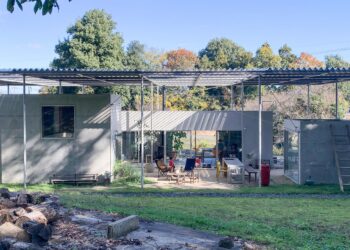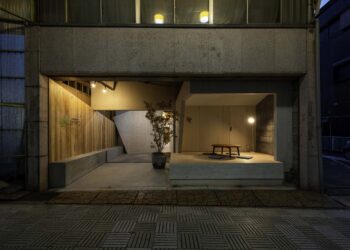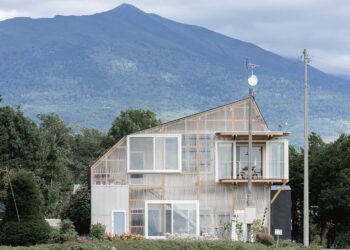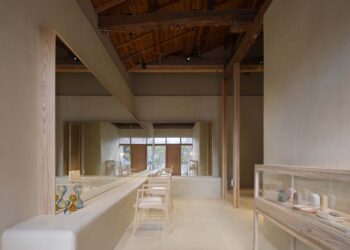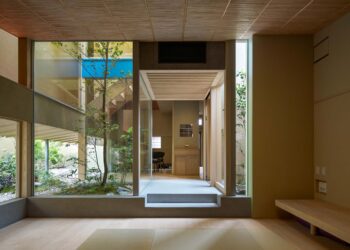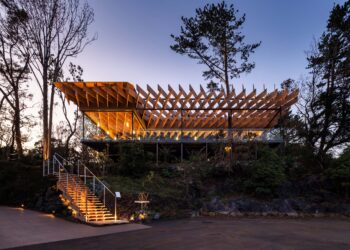A Japanese wooden residence is transformed into a kindergarten, housing it under a new roof and curtain wall
일본 목조 가옥을 개조하고 새 지붕과 커튼월을 얹은 마쓰자키 유치원
Shigeru Aoki Architect & Associates | 시게루 아오키 아키텍트 앤 어쏘시에이츠
Located in Yamaguchi prefecture, Japan, the Matsuzaki Kindergarten now occupies a redeveloped, highly memorable, hundred-year-old building already present on the site.
In order to retain the established, aging building, the architects preserved the real wood structure – which is rare nowadays – despite its dilapidated condition. To do this, the architects utilized a “Refining Architecture” philosophy to keep and develop the building, encasing it within a new, modern structure.
일본 남부 야마구치현에는 100년 된 집을 개조한 유치원이 있다. 기존 건물의 상태가 좋지 않았지만 오늘날엔 보기 힘든 전통 목구조를 간직하고자 했다.
Project: Matsuzaki Kindergarten Playroom / Location: Yamaguchi, Japan / Architect: Shigeru Aoki Architect & Associates – Yasunori Waki / Area: 370.42m2 / Completion: 2019 / Photograph: Shigeru Aoki Architect & Associates
By integrating the new with the old, the house is being reused for new functions, such as a playroom and canteen, while retaining certain distinguished, traditional Japanese elements such as the warehouse and tearoom space, and the ceiling structures. The H-shaped layout enabled the house to be separated in different ways.
건물을 최대한 살리되 현대식의 철골 구조물을 덮어씌웠다. 기존 지붕의 기와를 들어내는 대신 박공 모양의 외피로 전체를 감싸, 주택으로서 온전한 역할을 못하던 건물을 살려냈다.
커튼월 외관은 지나가는 사람들이 내부를 들여다볼 수 있어 유치원과 주민 간 연결고리를 형성한다.
The south wing is designed to be a large space, used as a playroom and canteen, therefore its unnecessary earth walls and finishes were removed to reduce the building weight. Only the frame structure and hanging partition walls were retained, which was sufficient for seismic resistance and creates a more generous and open interior ambiance. The existing building had its roof tiles removed and then covered by steel frame, so that the house is no longer functioning as a building per se, but has become a playground under the larger, all-encompassing roof. The north wing has been renewed without transformation, to use as kitchen, a toilet and as storage.
As the remaining old wooden frame in the canteen space surrounds the kindergarten children, it allows them to see, touch, and sense the architecture by themselves, in a way that stimulates their curiosity and educates them about traditional practices at the same time. Moreover, the curtain wall on the building’s new façade also reveals its inside activities to passersby, creating a connection between the kindergarten and the local people.
내부를 구획하는데 본래의 H형태 배치를 적극적으로 활용했다.
남측에는 옛것과 새것의 적절한 조합으로 놀이방과 급식실이 들어섰다. 탁 트인 공간을 만들고 건물 무게를 줄여 지진에 견딜 수 있도록 불필요한 흙벽과 마감재를 제거했다. 기본 골조와 상부 벽만 남은 고택의 흔적은 아이들의 호기심을 자극한다. 아이들은 직접 보고 만지고 느끼면서 전통을 배운다.
북측은 부엌, 화장실, 창고로 개조했다. 새로운 자재로 교체하는 대신, 창고와 다실, 천장 구조물과 같이 일본 특유의 요소는 그대로 살려두었다.





























 0
0












